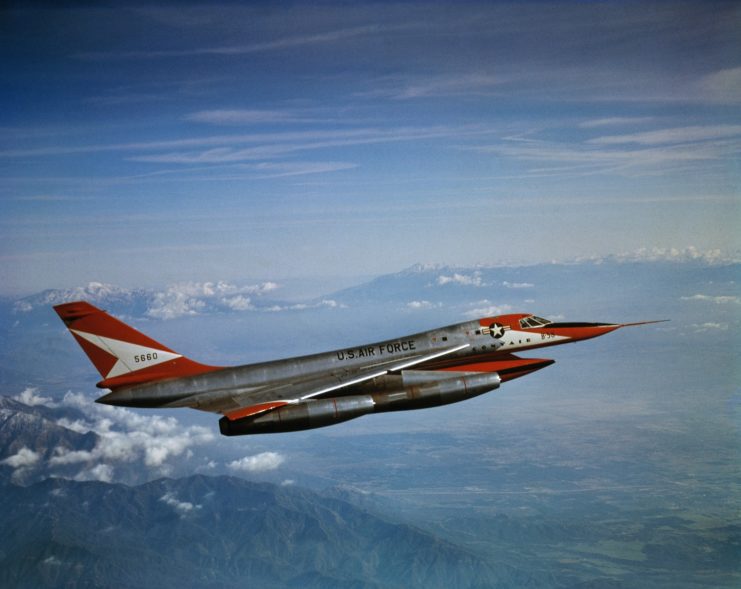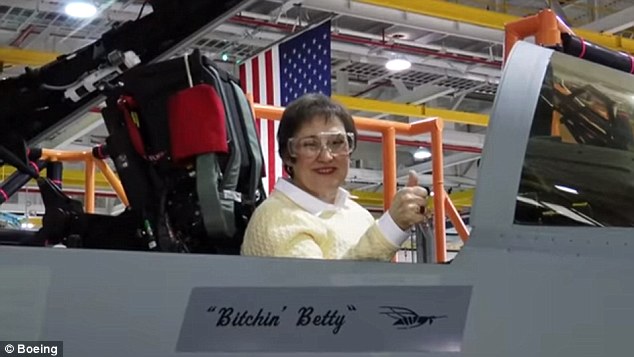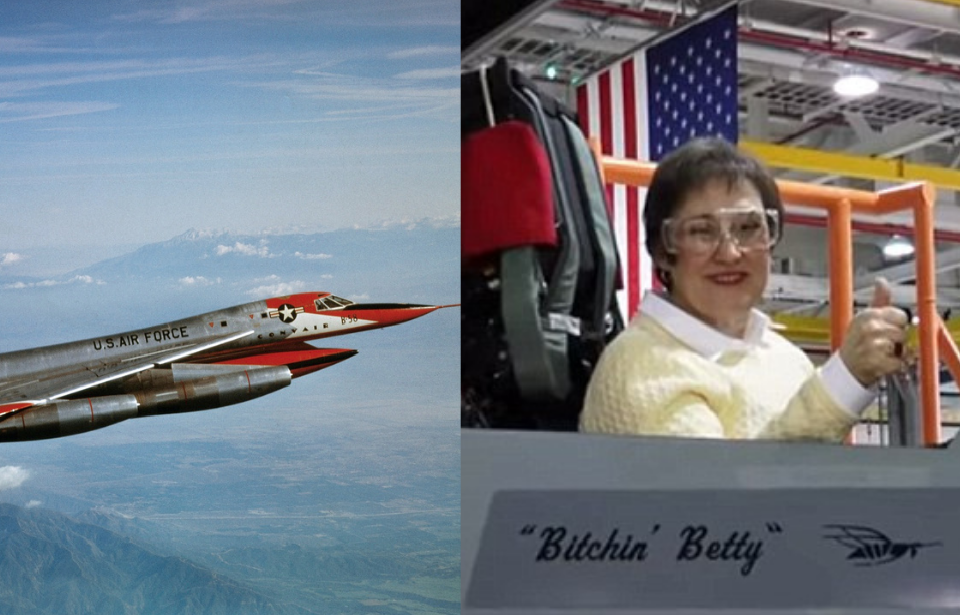When the Convair B-58 Hustler debuted on November 11, 1956, it was the first bomber to achieve Mach II flight. The bomber went operational on March 15, 1960, and remained in operation until January 31, 1970.
The relatively short lifecycle of the Convair B-58 Hustler owes to the fact that the Soviet military developed high-altitude surface-to-air missiles. The B-58 was initially designed to carry a single nuclear warhead at high altitudes while traveling at supersonic speeds, a deterrent meant to avoid soviet interceptors.
Almost immediately upon its release, the plane experienced numerous shortcomings, namely operational expenses that quickly skyrocketed along with a high rate of accidental losses. The jet also required a higher degree of aerial refueling, making it more expensive to operate than the Boeing B-52 Stratofortress.

While there were numerous innovative advancements and shortcomings for the Convair B-58 Hustler, one aspect of the plane offered a unique view into the mindset of male pilots. The plane was outfitted with a first-of-its-kind voice system that was considered cutting edge and ambitious at the time of its release. The B-58 featured numerous warning lights and buttons, but it was the automatic voice alert system that offered audible alerts through each pilot’s helmet set. The voice was delivered through an onboard magnetic tape system.
Researchers at Convair decided that a woman’s voice appeared to better gain the attention of young men, especially when they were engaged in distracting situations.
The very first voice, heard by male pilots, was that of singer and actress Joan Elms. Almost immediately, pilots started referring to the automated voice system as “Sexy Sally.” The system was developed by the Nortronics Division of Northrop Corporation. Among her warnings were critical notifications such as: “weapon unlocked,” “check for engine fire,” “hydraulic system failure,” “check for engine fire,” and “nose too high.”
New Voice Warning Systems Soon Followed
As the years progressed, both male and female voice systems were integrated into various aircraft, including helicopters. Many of the newer systems allowed the pilot to choose which gender they hear during flights. Pilots often refer to women’s voices inside the cockpit as “Bitching Betty” while a male’s voice is often called a “Barking Bob.”
The original “Bitching Betty” was voiced by Kim Crow and was heard by both pilots and astronauts. Another version was offered up by Erica Lane who lent her voice to the General Dynamics F-16 Fighting Falcon and the Boeing AH-64 Apache Helicopter. It’s worth noting that Kim Crow provided the first digitized voice for aircraft warning systems. Crow’s voice was used within the aural warning system for the F-15 Eagle and started with only several notifications that included “warning, engine fire, and overheat.” As the years progressed, Crow’s voice provided an entire litany of additional warnings. Sue Milne’s voice was then tasked with voicing the Eurofighter Typhoon.

In recent memory, it’s likely the voice of Leslie Shook that pilots can recall from memory. Shook voiced the popular Boeing F/A-18E/F Super Hornet.
Shook revealed that she listened to Kim Crow’s digitized voice recordings as she prepared to record her own voice for use in the F/A-18 Super Hornet. Interestingly, Shook landed the gig by accident. She had been working in video production at McDonnell Douglas, which was later acquired by Boeing. When preparing to record the voice of a female voice actor, Shook was forced to explain how the words should sound. Shook later explained to NPR that after spending hundreds of hours around flight simulators she knew the cadence expected from prior Bitching Betty recordings.
Shook wasn’t the only female to provide her voice while working in the industry. Patricia Hoyt not only provided the voice warning system for the Boeing 7171 and Boeing C-17 Globemaster III, but she was also a mechanical engineer working on the Boeing 717 at the time she offered up recordings of her voice.
Do Female Voiced Warning Systems In Aircraft Really Matter?
In 1996 a team of researchers at the Defence Research Agency in the UK examined the Collision Warning System Technical Demonstrator Programme and noted that pilots asked for a female voice because they believed it offered “greater clarity” when delivering messages. However, the results may be negligible according to recent research and based more on voice factors such as intonation and speed, among other factors.
It’s still unclear if a female voice makes a large enough difference to discern. Much of the speculation comes from first-hand accounts from pilots. During World War II a large number of air traffic controller jobs were held by women. According to the Federal Aviation Commission (FAA), women started to replace males in air traffic control as those men left to serve in the war. Some largely unverified accounts from male pilots have claimed that a female voice was easier to discern among a flurry of radio chatter being delivered by male counterparts.
A report by CNN in 2011 suggests that female voices were chosen because they stood out, as suggested above. The article further notes that telephone operates were also mostly female, a fact that likely made male pilots accustomed to hearing a “disembodied woman’s voice.”
A 2003 study at Plymouth University in the UK has questioned the reliability of long-held beliefs regarding female-voice systems. The study suggests that it’s the “greater range of urgencies due to their generally higher pitch and pitch range” that give female voices an advantage in aircraft warning systems. In that case, a simple change to acoustic variables could lead to better results regardless of the speaker’s gender.
The research carried out at Plymouth University was expounded upon in a 2009 study at Defence Research and Development Canada in Toronto, Ontario. In that study, researchers simulated cockpit background radio traffic using a male voice in place of a female voice. Researchers had male and female actors annunciate warning words in three styles: monotone, urgent, and whisper.” The research “found that with simulated cockpit background radio traffic, a male voice rather than a female voice, in a monotone or urgent announcing style, resulted in the largest proportion of correct and fastest identification response times to verbal warnings, regardless of the gender of the listener.”
A study published in 1998 in Aviation, Space, and Environmental Medicine, found that a woman’s voice may actually provide sub-par results compared to a male’s voice when cockpit levels climb above 115 db. Researchers conducting the study concluded that “The intelligibility of female speech was unacceptable at the highest measured noise level of 115 dB and may constitute a problem for other military aviators. The intelligibility degradation due to the noise can be neutralized by use of an available, improved noise-canceling microphone, by the application of current active noise reduction technology to the personal communication equipment, and by the development of a voice communications system to accommodate the speech produced by both female and male aviators.”
Regardless of studies and tests, it’s clear from past testimonials that many male pilots have found perceived noticeable advantages to hearing a female voice during combat-based operations.
A Legacy Beyond Aircraft
Sexy Sally may have long been replaced, along with her short-lived Convair B-58 Hustler but her place in history lives on with the likes of GPS navigation, Apple’s Siri, and various other voice-activated systems that still default to female-voiced systems. In the 1980s the Datsun Maxima featured a high-tech voice warning system at the time. The Datsun system used a female voice to tell drivers when “lights are on” or “left door is open.” Datsun called the system the “Talking Lady.”
While the verdict is still out, it’s clear that voice warning systems often still favor female voices, even when a male option is readily available.
